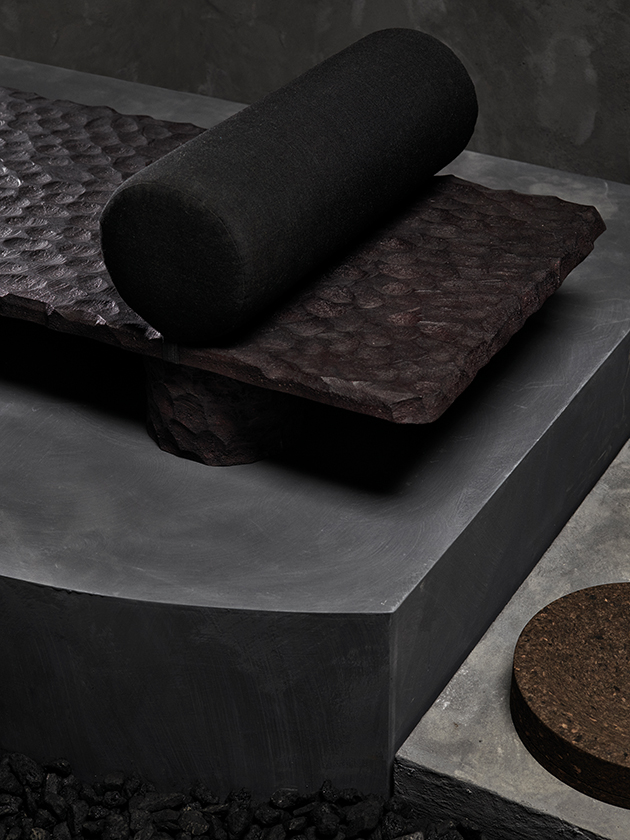
The six designers who come together as Brut are united by bold architectural forms, brooding melancholia and a quintessential Belgian-ness writes Laura Snoad
Occupying an industrial unit in the northerly reaches of Milan’s Isola district, Belgian collective Brut debuted its first collaboration during April’s furniture fair. A group of six designers – Ben Storms, Charlotte Jonckheer, Bram Vanderbeke, Cédric Etienne of Studio Corkinho, Nel Verbeke and Linde Freya Tangelder – their work punctured the bubble of cheerful pastels and saccharine millennial pink still enveloping much of the design community. Dark, dense and brooding, the collection was a dialogue of heavy, archetypal shapes in industrial materials. Chipboard, aluminium, and cork had been carved, sanded and scorched – a human interjection to factory-born processes. The entire collection skulked in a monochrome scenography shaped from a sea of coal: a nod to Belgium’s mining heritage.
‘We feel there is something very Belgian in our aesthetics and the way we work,’ says Charlotte Jonkheer. ‘Belgian design is very diverse,’ adds Bram Vanderbeke. ‘People are free to do whatever they want, and perhaps that’s a typically Belgian thing – that kind of freedom. But our link to Belgium is more a feeling you have when you are in Belgium. It’s the way we treat materials. It’s no-nonsense.’ Jonkheer also recognises this directness. ‘The Belgian attitude is very straightforward,’ she adds. ‘When you look at the art, there’s a lot of bold movement and there’s something very melancholic about it. Belgian artists and designers are very grounded.’

The collective itself started not in Belgium but in the Netherlands, with the meeting of Brut’s three female members at Design Academy Eindhoven. An exhibition at Turin’s Operæ gallery brought all six together, but they were already well versed in each other’s conceptual and aesthetic similarities, having exhibited together previously in various constellations. The decision to set up Brut was largely practical. ‘In Milan, it’s an enormous deal to rent a space big enough to create a statement on your own,’ explains Jonkheer. ‘Or if you show in an exhibition, you can’t decide who’s next to you. Here we knew exactly which works were going to be where, and we could create a common ground between them.’
Brut established this conversation between works collectively, assembling images of their furniture and objects on a kitchen table and picking two pieces – one old and one more recent – from each designer until the result resembled a coherent collection. From here the aesthetic interests that had exuded a magnetic pull over the six designers became all the more apparent. The block-like structure of Linde Freya Tangelder’s Archetyping daybed (a sculptural piece made from carved aubergine-pigmented chipboard and a velvet cushion), is reflected in Cédric Etienne’s BS01 chair, a ‘modular system’ of burnt cork blocks, put together to create a rudimentary seat much like hay bails at a harvest festival. Both embody a tension between hardness and softness, with their materiality straddling craft and industry.
An experimental approach to materials runs through each of the designers’ work. Jonkheer’s Chaud side table, for example, presses recycled print offprints with stone residue in a mold to create a curved composite, its shape partly dictated by the humidity of the air during the drying process. Likewise, the final form of Ben Storm’s InHale side tables and Untitled daybed cannot be entirely controlled by the maker. Part of an ongoing experiment in blowing metal, InHale is made from a chunk of marble that balances on top of a blown metal cushion, resembling an inflated, unbranded crisp packet.

Architectural structures are repeatedly referenced throughout Brut’s debut collection. Tangelder’s Cross Vault seat is a bent aluminium rendering of the negative space inside a cross vault ceiling, sanded by hand to give a cloud-like finish. Vanderbeke’s Stackable stools can be piled up to create columns, benches, and podiums. ‘It’s a kind of building stone for interior spaces – it’s very much an architectural element,’ he says. Tangelder chimes in, ‘I think this concern with architecture is something very Belgian as well; it’s an area we’re very strong in.’
The melancholic Belgian temperament that Jonkheer identifies can be seen in her Impressions rug, a study on the colour of grey achieved by varying the thicknesses of black and white wool yarns. ‘When you see Belgium from the air, it’s very much graphical shapes,’ she explains. ‘In the piece, you have a combination of really earthy wool (a very grounded material), woven together with warm linen, and then you have a mist covering it, made of natural silk.’ This poeticism is also seen in the work of Nel Verbeke, whose hourglass-shaped side table in rusted steel is filled with little metal bowls, which rattle down its interior when upturned. ‘Instead of seeing the time passing, you hear it,’ says Jonckheer.
Although Brut doesn’t intend to make pieces collaboratively, its next step is to curate a group show, with each designer making new work on a theme. ‘We want to keep our individual practices, but see Brut as a place where we can show work in relation to each other,’ says Vanderbeke. ‘The Milan show was very interesting,’ adds Jonkheer, ‘because many visitors saw the work as a collection. When you see the work separately, you can identify each of the designers, but then when they come together they blend in and create common ground.’ Tangelder adds, ‘They get stronger next to each other, as does the story.’

















